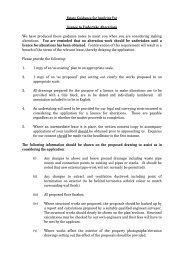Chelsea Insider Low - Cadogan
Chelsea Insider Low - Cadogan
Chelsea Insider Low - Cadogan
- No tags were found...
You also want an ePaper? Increase the reach of your titles
YUMPU automatically turns print PDFs into web optimized ePapers that Google loves.
5 | HISTORY | A short history of <strong>Chelsea</strong>A short history of <strong>Chelsea</strong>HistorySloane SquareA powerful pastFrom humble origins as a tiny Thamessidefishing village, <strong>Chelsea</strong> grew to bea religious centre, an artistic hotspot,and a favourite of the wealthy. Wereveal the area’s fascinating history,from the Romans to Roman Abramovich<strong>Chelsea</strong> has had a rich and interestinghistory, and this is a brief overview ofhow it developed into today’s wealthy,bustling area. For more information onspecific streets, places and people, seeStreets and SightsEarly historyThere is some limited archaeologicalevidence of prehistoric activity in<strong>Chelsea</strong>. Flint and pottery fragmentshave been unearthed near <strong>Chelsea</strong>Common and <strong>Chelsea</strong> Old Church.A Neolithic flint sickle, an oak club or‘beater’ dated to 3540-3360 BC, andpart of a human skull were all found onthe Thames foreshore.‘<strong>Chelsea</strong> Man’, as the prehistoricowner of the skull fragment is nowknown, died between 1750-1610 BCand had been subjected to trepanation,a surgical procedure in which a hole isdrilled or scraped through the patient’sskull in order to relieve afflictions suchas migraine, or in an attempt to treatmental illness. The procedure was notuncommon and would have beenperformed on a conscious patient,without anaesthetic, with a piece offlint for a surgical tool. A form of theprocedure is still practised today to treatpatients suffering a build-up of bloodaround their brains.‘<strong>Chelsea</strong> Man’ survived this ordeal, aswe can tell by the bone regrowth aroundthe edges of the hole in the skull, only todie six months later.Roman timesLittle is known about <strong>Chelsea</strong> in theRoman period, although pits, ditches,and a timber structure found under the<strong>Chelsea</strong> Old Church churchyard indicateRoyal Borough of Kensingon & <strong>Chelsea</strong>, Family & Children’s Servicethat there may have been a small ruralsettlement there.A few metres away, at 6-16 OldChurch Street, a pit and a shallow ditchcontaining third century AD Romanpottery suggests that the area wasoccupied in some way at the time. It isalso possible that Julius Caesar used thelow waters in the <strong>Chelsea</strong> section of theThames at the time cross itduring his invasion of Britain in 54 BC.Anglo-Saxon timesA fishing village emerged around the siteof <strong>Chelsea</strong> Old Church during the Anglo-Saxon period, and two large mid-Saxonfish traps, originally thought to have beenwharves, have been uncovered on theThames foreshore, giving an insight intoThe Old <strong>Chelsea</strong> Bun Houseby Walter Greaves







